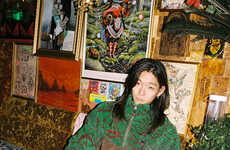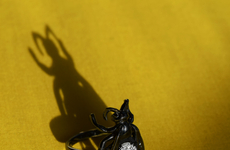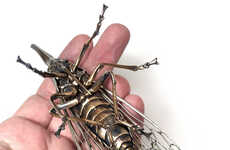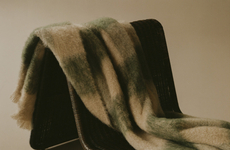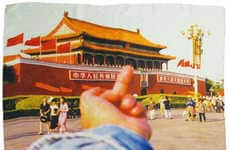
One Million Spiders Made the Golden Silk for RareTextile
Katie Cordrey — September 26, 2009 — Eco
More than a million wild spiders were needed to produce the silk for a golden colored cloth that is on display at the American Museum of Natural History in New York City. The golden orb spider of Madagascar can grow to be as large as a human hand. In addition to eating birds, the spiders spin saffron-colored silk thread with a tensile strength five to six times stronger than steel by weight.
Simon Peers, a British art historian and textile expert and Nicholas Godley, an American fashion designer both living in Madagascar teamed up five years ago to produce golden silk from native golden orb spiders. The technique had not been tried for more than 100 years. The end result is a stunning one-of-a-kind 11-foot-long cloth.
The spiders used to create the fabric were tracked for yield and casualty rate. Some died, but the surviving spiders were released daily. Peers and Godley plan to help protect the spiders and to use them to create future projects.
“We have become sort of the defenders of these spiders, something we never thought we’d be,” said Mr. Godley, who calls himself a committed arachnophobe, but added, “They really are very regal-looking creatures.”
Simon Peers, a British art historian and textile expert and Nicholas Godley, an American fashion designer both living in Madagascar teamed up five years ago to produce golden silk from native golden orb spiders. The technique had not been tried for more than 100 years. The end result is a stunning one-of-a-kind 11-foot-long cloth.
The spiders used to create the fabric were tracked for yield and casualty rate. Some died, but the surviving spiders were released daily. Peers and Godley plan to help protect the spiders and to use them to create future projects.
“We have become sort of the defenders of these spiders, something we never thought we’d be,” said Mr. Godley, who calls himself a committed arachnophobe, but added, “They really are very regal-looking creatures.”
Trend Themes
1. Spider-spun Textiles - Opportunity to explore the use of spider silk as a sustainable and durable fabric for apparel and textiles.
2. Wildlife-based Materials - Exploring the possibility of using exotic materials from animals in product design as a way to differentiate from the competition.
3. Eco-friendly Fashion - Opportunity to create sustainable fashion by using materials that have a minimal impact on the environment and support wildlife conservation efforts.
Industry Implications
1. Fashion - The fashion industry can explore the use of innovative materials like spider silk to create unique and eco-friendly apparel.
2. Textile Manufacturing - The textile industry can incorporate wildlife-based materials like spider silk into their manufacturing processes to create new, sustainable products.
3. Ecology and Wildlife Conservation - The field of ecology and wildlife conservation can benefit from collaborations with designers and fashion brands that support the use of sustainable, animal-friendly materials in fashion and product design.
5.1
Score
Popularity
Activity
Freshness

